Zero #1 (Image, $2.99)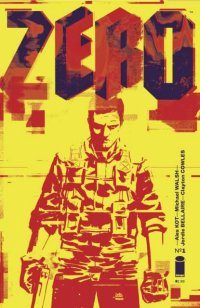
by Graig Kent
Robert Kirkman had a dream, a dream where comic book creators could be free to write and draw the stories they wanted to, free of editorial whims and fancies, free of needing corporate crutches to maintain relevance. The only thing standing in the way of Kirkman’s dream was the heaping piles of cash and needed medical benefits writers and artists made from being in the pocket of the property-perpetuating machine. But it seems that, 5 years later, and with the rampant success of the Walking Dead that Kirkman was onto something, and that perhaps focusing on making creator-owned titles the best they could be, focusing on taking creator owned work out into more popular media of television and/or film and/or video games could be far more satisfying and rewarding than working for the man. We’re seeing the results of this quasi-manifesto Kirkman introduced all over the place, with a lot of writers and artists sticking to the fringes, purposefully avoiding the DC and Marvel trap, making their own way and telling their own stories.,
Ales Kot is a young writer in the comics game, having just recently come up making a bit of an impression in the past year with a couple of Image projects: the challenging Lovecraftian hip-hop fable Change (what a gross oversimplification that descriptor is) and pairing up with artistic wonder Riley Rossmo on an oversized one-shot, Wild Children. He made a bit of a splash earlier this year taking over the Suicide Squad at DC, gaining the New 52 book its first real accolades, and then made an even bigger splash by exiting the title after only four issues. Zero is his first post-DC project (though likely in the works long before) and it shows a creator invested in his work, telling a story that he wants to tell, his way.
Zero runs from cover to cover, the story beginning in the inside front cover, concluding inside the back cover. It’s an interesting investment the creators decide to make (and are allowed to make at Image), knowing that they’re running 10 to 12 pages longer than most other comics, for the lower average price point, meaning less of a monetary return for the effort put into it. But it also shows that the creators are indeed invested in their story and maximizing their space to tell it. It’s the kind of decision that’s as much a storytelling decision as a design decision as a sales decision. Whatever the reason, it’s noticeable and it has an impact.
The story itself is like a reinvention of the Universal Soldier and/or Bionic Man properties. Set in 2018, it features cybernetically enhanced soldiers engaged on the warfield, in this case it’s an Israeli and a Palestinian soldier tussling for reasons unknown, other than they’re enemy combatants. Zero is an operative for The Agency, the inventors of this biotechnology, and it’s his responsibility to retrieve the stolen tech that has wound up inside the Palestinian, at any cost. The bulk of the book is a massive fight sequence, with Zero largely in the periphery, trying to avoid getting caught between the two biomodified warriors, trying to find his opportunity to get in there and accomplish his objective, and dispensing with anyone who sees his face.
But there’s something else at play. The first page, inside the front cover, finds Zero, 20 years in the future, sitting in a chair on the edge of a bluff, beer in hand and a gun to the back of his head. A boy, not even a teenager yet, holds the gun. The rest is the story Zero tells him. There’s side-steps in that story to the Agency and Zero’s handlers (always a bit of a peeve is when a story is supposed to be narrated by a character but presents conversations and situations to which the narrator could not have been present), providing slight exposition on the Agency and Zero’s background with them. Zero’s the typical character for these situations: tough, quiet, clever, ruthless, but it’s an effectively used archetype.
Kot wouldn’t be anywhere though without the visuals to back him up, and artist Michael Walsh is up to the task. Walsh jumped into view earlier this year with solid work on the Image mini-series Comeback, and even more prominence on The X-Files Season 10. His style is perfectly suited for an X-Files book, maintaining a consistent feel as Charlie Adlard, X-Files (and Walking Dead) illustrator of old, so it lends an equal familiarity here. There’s a muddiness to his inking (assisted by Adam Gorham) that is fitting for the grimy terrain of a decimated, war-ravaged middle-eastern city. Like how Sean Phillips has become a quintessential illustrator of noir, Walsh his finding his groove in naturalistic, light science fiction fare, it just fits. Colorist extraordinaire Jordie Bellaire has to be one of the hardest working people in comics today (right behind Brian Wood maybe?) but there’s no secret to why she’s getting so much work. She’s amazing. Starting with a blue filter for the scenes in the future, providing a cold, sterile grey and green wash for the Agency headquarters, and sticking with earthen tones for the Palestine sequences that only get progressively more and more soused in red as the fight wages on, it’s all subtle but extremely effective.
It’s not a revolutionary title, but it’s got a definite hook. Fans of action but with a splash of intrigue should be all on top of this.
Rating: 




Out of a Possible 5 Stars
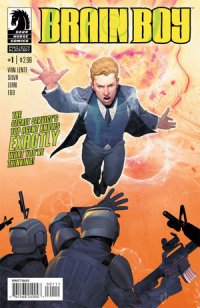 Brain Boy #1 (Dark Horse Comics, $2.99)
Brain Boy #1 (Dark Horse Comics, $2.99)
By Adam X. Smith
I know that lately I’ve been conspicuously harping on about my break-up with DC Comics that was totally mutual lately, but I find myself looking at what they used to have with Vertigo with a sad sense of longing for an imprint that was sustained by the abundance of horror and supernatural comics that weren’t getting much love as neutered, post-Comics Code fables before Karen Berger transformed that corner of DC in the late 80s into a thriving alternative label that hoovered up talent like a particularly eager Tony Montana hoovering up other substances.
So where have all the good times gone, you ask? Bratty older brother DC has yanked all the toys out of baby sister Vertigo’s play-pen and left her with just a spaceman toy that is pretty to look at but only a few people play with actively, a book of Grimm’s fairy tales and a chewed up copy of a crossover between Anne Rice’s Lestat books and The Lost Boys. Vertigo has had hundreds of ongoing titles over the years and at any given time, they were bustling with activity, working with and attracting the best in the industry, providing up-and-coming writers and artists with opportunities and giving homes to characters that couldn’t hack it in the rat-race of the mainstream. Now they have barely a dozen ongoing series, drained dry by executive mandate that those not born into the Vertigo stable from whole cloth return to the New 52 to be accounted for and made use of, with even the grizzled John Constantine, who had survived cancer and eternal damnation through cunning alone, being forced to go behind the bike-sheds and do unspeakable things with old men as the price of his numerous deals with the Devil and DC editorial. The old pale horse ain’t what it used to be.
So what that leaves us with is a distinct lack of good horror and fantasy output from the main superheroics crowd. Lucky for me, then, that I was recommended a new book from Dark Horse based on a character that they apparently found in a bin: Matt Price, aka the titular Brain Boy (a nickname he hates but that people insist on calling him), a plain-clothes psychic superhero/government lackey who was co-created in the 60s by Herb Castle and Gil Kane to fight communism (of course he was) and other “enemies of freedom” who would usually also have psychic powers (of course they do). Be reassured though that Dark Horse and writer Fred Van Lente aren’t in the business of making boring comics about boring characters, and Matt is by no means as one-note as his origin (parents died in a car-crash blah blah, raised by mentor blah blah, secret government blah blah) would suggest.
For starters, Matt Price, as written, is sharp. Razor sharp. Not a Mary Sue, mind you – he can still be caught off guard physically and mentally – but certainly self-aware enough to realise he’s a witting (though hardly defenceless) pawn of the military-industrial complex whilst still reaping the benefits of it – the salary, the car, the suits, the women. But his work as a private security asset guarding diplomats and politicians is hardly the most rewarding, especially when it involves getting piss-bottled by protesters and having to deal with people who would just as soon prefer him dead on a daily basis (and that’s goes for the ones he works with especially). As if you needed to be told anyway, having superpowers – particularly telepathy – isn’t all it’s cracked up to be. As he notes early on, all the dates he has with women (all micromanaged by his handlers no less) cannot change the fact that he can simply read their minds and finds the contents thereof almost always mind-numbingly dull. Matt revels in and is shackled to his powers, and all his expensive suits and toys are distractions in a gilded cage that he’s been in too long to break free of.
That’s not to say the book isn’t fun – far from it. R.B. Silva’s pencils, Rob Lean’s inks and Ego’s colours do a fair approximation of Stuart Immonen’s art on Nextwave, Agents of H.A.T.E. with a little more meat on the bones, and Van Lente’s masterful use of captions and thought-bubbles is up there with the likes of Jeph Loeb’s work for bringing a sense of immediacy and verisimilitude to the characters’ internal narrative. The reason I’m not discussing plot too much is mostly due to it involving details I’d rather not spoil – I mean, there’s some gubbins about “what really happened to his parents”, but there always is with these things – and even after not being able to get my copy until two weeks after release I want you, gentle reader, to go in as fresh as possible. I’d recommend this book highly to anyone as an alternative to the likes of Vertigo or who fancies seeing a reworking of a long-abandoned concept that deconstructs its subject without obliterating it by staring into its soul long enough for ego-death to set in. Dark Horse are clearly throwing down the gauntlet to the Big Two with this book, intent on showing that they are now in the superhero business too, and in this writer’s opinion, it’s a strong opening gambit.
Two weeks down, fifty to go.
Rating: 




Out of a Possible 5 Stars
Rat Queens #1 (Image, $3.50)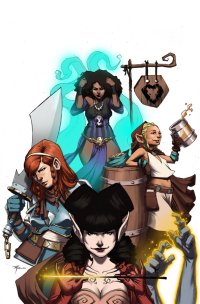
By Adam Prosser
Cultural osmosis is a force not to be taken lightly. A huge percentage–possibly even a majority–of the entities that tower over pop culture weren’t hugely popular when they first debuted; some of them were outright flops, or restricted to niche markets. And yet, as we’ve seen time and time again, a passionate fanbase is better for a property than a big one, or at least, it’s more crucial to its financial success. Stuff that seemed outright obscure can eventually become inescapable, over time, when people show an extended interest. That’s particularly true since nerds began to dominate pop culture in the last 15 years.
Take Dungeons and Dragons. While it might be a stretch to say that it’s “everywhere”, this once-geekiest and most specialized of hobbies has definitely saturated the popular imagination–everyone at least knows what it is, even if they’ve never played it and have no intention of doing so. And while comic books are hardly the cutting edge of cultural significance, it’s got to mean something that “snarky dungeons and dragons-inspired fantasy humour comic” has become an entire sub-subgenre unto itself–The Guild, Skull Kickers, and now Rat Queens.
Summarizing Rat Queens #1 almost feels redundant after that last paragraph, as you can pretty much guess the broad strokes for yourself. A quartet of female adventurers–dark magic-wielding elf leader, ex-Lovecraftian-entity-worshipping cleric, dour warrior type and cheerfully hyper Halfling (or apparently a goblin?) go on quest, hijinx ensue. The central joke is that after a couple of successful quests, this team of nouveau-riche adventurers has gone into celebrity meltdown, getting drunk and wreaking far more havoc on their hometown than the monsters and bandits they supposedly protect it from. After being sprung from jail, they and a whole other array of themed adventuring teams (who collectively make the comic start to resemble a fantasy version of The Warriors) are forced to undertake “community service” quests as part of their bail conditions. Surprise of surprises, things take a more serious turn when your standard-issue Shadowy Assassins start bumping off the adventuring teams one by one.
Speaking of cult obsessions gone big-time: Joss Whedon. I was trying like hell not to mention him in this review, since I think we may all be a little Whedoned out lately, but his spectre hangs over this comic in a way that’s impossible to ignore. Whedon’s trademark snarky dialogue and subversion of action tropes against a more serious or even horrific backdrop has become pretty much the default mode for serialized genre storytelling, and this comic goes even further in trying to match Whedon’s tone, voice, and preferred subject matter of hip girly butt-kickers against ominous evil. Writer Kurtis J. Wiebe’s dialogue alternately charms and clunks; frankly, after watching Agents of SHIELD I’m pretty sure I’m getting burnt out on even Whedon’s own version of snappy patter, and Wiebe ain’t Whedon. The result can be grating overall, especially since the concept is pretty paint-by-numbers so far, and Wiebe’s trying just a little too hard to be hip and edgy. But the writing is redeemed by some small, subtle touches and a couple of legitimately good jokes, like the ultra-serious team of goth adventurers assigned to cleaning the latrines.
Also strongly in the plus column is artist Roc Upchurch; just as mannered dialogue on screen can succeed or fail depending on the actors’ delivery, Upchurch’s extremely expressive characterizations and excellent sense of timing and composition deserves a lot of the credit for the gags that do work. It’s actually pretty rare to see an artist in mainstream comics who knows not just how to sell a joke, but to enhance it, but Upchurch is definitely in that category. Thanks to him, Rat Queens gets a whole extra star. As for the story, there are hints that Wiebe may be setting something up beyond “A dungeons and dragons campaign, except WACKY!!” but he’s not really making himself heard yet above the general din of everyone else’s ideas.
Because that’s the other thing about cultural osmosis: what starts small can become overwhelming, and it’s too easy to follow along in everyone else’s footsteps. Originality is what wins out in the long run. Rat Queens is rather amusing, but it’s hard to imagine it lingering in anyone’s memory. It’s the result of absorption rather than the kind of thing that gets absorbed.
Rating: 




Out of a Possible 5 Stars
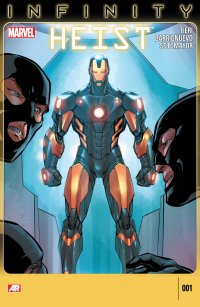 Infinity Heist #1 of 6 (Marvel, $2.99)
Infinity Heist #1 of 6 (Marvel, $2.99)
Trial of the Punisher #1 of 2 (Marvel, $3.99)
By Jeb D.
Whatever else one can say about Brian Bendis’ influence on the Marvel Universe, and Marvel Comics as a corporate entity, his run on Daredevil cemented the viability of indie-style street-level crime stories in a superhero comic universe. Writers like Bendis, Ed Brubaker and Greg Rucka used the tools of the urban-crime novelist to find a middle ground between the bleak “grim n gritty” storytelling that followed in the wake of Watchmen and Dark Knight Returns, and the genuinely “heroic” approach associated with more conventional superhero storytelling. That the influence is still going strong is demonstrated in the quirky, indie sensibilities that fuel some of Marvel’s best current comics, including Hawkeye and The Superior Foes of Spider-Man.
Superior Foes, in fact, is sort of the touchpoint for Infinity Heist, as well as being an unfortunately timely point of comparison. Frank Tieri has long been Marvel’s go-to guy for two things: C-list bad guys and irrelevant event tie-ins (World War Hulk: Gamma Corps, Civil War: War Crimes), and Infinity Heist is both: a story of some of Marvel’s run-of-the-mill villains planning a big score while the Avengers are off-planet; they’re targeting the big guy left behind, Tony Stark, and his quajillions’ worth of tech toys and IP. As I say, it’s not really specific to Infinity, since there’s at least a half dozen crises per year that would occupy the Marvel heroes sufficiently for guys like Blizzard and Whirlwind to crawl out from under their rocks and get hooked up with a job like this.
That’s actually its first point of comparison with Superior Foes: the titles come more from the marketing department than anything having to do with the actual story. The second point, of course, is the surface similarity that both comics take us inside the lives of the low-level bad guys that superheroes typically dispatch in a quick splash page or two, and on that basis, I think that Infinity Heist would come off a lot better if Nick Spencer and Steve Lieber’s vastly um… “superior”… title weren’t running concurrently. Tieri and artist Al Barrionuevo have fun with the concept, but the comic timing of Spenser and Lieber is the kind of thing that you either have or you don’t, and the pacing of Superior Foes means that every punch line lands perfectly, every throwaway comment advances the story or delves a bit deeper into character; for all its charm and good intentions, Infinity Heist can’t quite match that consistently rewarding level of excellence.
Actually, apart from the stock bad-guy characters, a better comparison for Infinity Heist would be Avengers A.I.: where Spencer and Lieber’s Superior focuses on character to drive the loose-limbed plot, Tieri’s Heist, like Sam Humphries’ A.I. book, has a fairly conventional superhero-story structure over which he layers some good laughs. Barrionuevo’s classic-superhero art, while very appealing, and terrific in the action scenes, also tends to gloss over some of the humorous potential.
I certainly recommend Infinity Heist to fans of Superior Foes who just can’t wait for its next issue for their fix of humorous henchman hijinks, but anyone else looking to see what the criminal class of the Marvel U might look like to the eye of writers in the vein of Elmore Leonard or Carl Hiassen, should really start with Superior Foes.
The Punisher has long straddled the spandex and street-crime worlds, and though both Jason Aaron and Greg Rucka 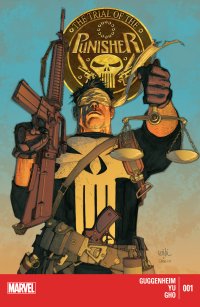 have theoretically put an end to Frank’s vigilante shenanigans in the MAX and regular Marvel Universes recently, you can’t keep a good piece of trademark down, and thus we have Marc Guggenheim’s shelved-and-dusted-off Trial of the Punisher. I’ll cut Guggenheim some slack for his erroneous contention that this will be Frank Castle’s first trip to the courtroom (“See: Peter Parker, the Spectacular Spider-Man #83—Jaunty Jeb!”), because it’s certainly a topic that hasn’t been explored much, when you consider how much violence Frank has been on both sides of over the years.
have theoretically put an end to Frank’s vigilante shenanigans in the MAX and regular Marvel Universes recently, you can’t keep a good piece of trademark down, and thus we have Marc Guggenheim’s shelved-and-dusted-off Trial of the Punisher. I’ll cut Guggenheim some slack for his erroneous contention that this will be Frank Castle’s first trip to the courtroom (“See: Peter Parker, the Spectacular Spider-Man #83—Jaunty Jeb!”), because it’s certainly a topic that hasn’t been explored much, when you consider how much violence Frank has been on both sides of over the years.
But while a genuine exploration of The Punisher’s relationship to the justice system would be a worthwhile subject for an extended story arc, or full blown graphic novel, Guggenheim’s story is somewhat hampered by running for just two regular-sized comic issues. Instead of Frank finding himself in the courtroom by means of the wheels of justice turning in an unexpected direction, he shows up at a police station, with the tortured corpse of a man he confesses to having killed, and turns himself in, with the expected beatings at the hands of vengeful cops and threats that he won’t make it out of jail alive.
The brevity of the series has forced Guggenheim to begin with a stolen base: we know this is all in aid of some scheme of Frank’s, and we know that it will come to fruition quickly because there’s simply no time for any particularly challenging obstacles along the way. Guggenheim has a good handle on Frank’s narrative voice, and his legal background helps him provide exposition without dumbing things down for the cheap seats. I have to wonder, though, just how often he actually encountered a public defender like Frank’s: Lisa Santos is sexy, sharp, smart, stylish… and evidently has a light enough case load that she can spend time coming up with off-the-wall ideas for Frank’s insanity defense.
Considered solely as a story, this would be a decent three-star book; what elevates it beyond that is the rare chance to see artist Lenil Yu when he’s not bringing the ‘splode. And while I can’t deny that the man is fantastic at the cosmic craziness which he’s usually tasked with, his work here is revelatory. He takes settings we’ve seen over and over again (mean streets, police station, prison, courtroom) and nails just the right camera angles and perspectives to give Guggenheims’s script an urgency it would otherwise lack. His paneling is far more dynamic than you’d typically get for such a talky story, and the visual characterizations are clear, consistent, and vivid. He also handles the occasional bits of action as well as you’d expect.
The list of outstanding Punisher standalone minis from the past decade or so is awfully long (to say nothing of the regular series work from guys like Ennis, Rucka, and Aaron), and while Guggenheim’s script may not delve as deeply as the best of them, this book is a good choice for Punisher enthusiasts, and an abolute must for fans of Lenil Yu.
Infinity Heist #1: Rating: 




Out of a Possible 5 Stars
Trial of the Punisher #1: Rating: 




Out of a Possible 5 Stars
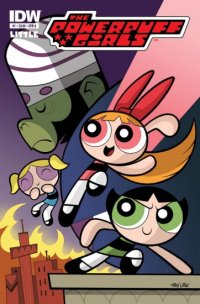 Powerpuff Girls #1 (IDW, $3.99)
Powerpuff Girls #1 (IDW, $3.99)
By Graig Kent
I was technically an adult by the time the Powerpuff Girls hit Cartoon Network, but as a child of the 1980’s I had a prolonged adolescence where things like cartoons and comic books still appealed to me greatly well into my… how old am I today? Anyway, the appeal of childish things never lost their luster, although by the time I reached my 20’s I began to approach appreciating these things through the filter of art and design as much as for entertainment value. When the Powerpuff Girls (PPGs) hit in the late 1990’s they were a much needed addition to popular culture: an action-comedy geared towards –but not exclusively so — young girls. At the same time, taking a page from Spongebob Squarepants, the incredibly unique aesthetic of Craig McCracken’s cartooning appealed to design nuts and cartoon freaks of all ages, and equally the whimsical, often meta humour played as much to a college crowd as it did its younger audience.
The PPGs were a revolution that failed to take hold in any larger context than its own success. Though it was wildly popular, it didn’t really lead to any great shift in perception about girls as action heroes or equal pop culture contenders. The Powerpuff Girls are definitely in the list of influences in the modern drive to acknowledge the XX demographic as a defining voice in genre culture, but there’s still not a lot of younger-audience action-oriented programming that features female leads (Word Girl and Legend of Korra the notable current exceptions). I acknowledge that PPG isn’t the same as Spongebob, but there shouldn’t be any reason why the show couldn’t have continued its run or resurge today as popular. It was always so easily accessible for all demographics, and it provided young girls with a taste of strong female characters close to their own age.
That said there’s never a bad time for the Powerpuff Girls to appear again, in any form. What would be even better is for them to reappear as strong and unique as they were originally, and that’s what writer/artist Troy Little brings to this new comic book. Little emulates the PPG animation style beautifully, in both line and colour, but he has his own unique flare, providing more shading than the cartoon and a richer story structure that’s employs both the episodic adventure of the cartoon but underpinned with some serialized elements.
The book opens with the City of Townsville on fire, and the typically bewildered Mayor once again bewildered by what’s occurring out his window. It’s Mojo Jojo, the hyper-intelligent monkey back at it again, this time in a mock-up of Ripley’s power armor from Aliens, storming through the city. He is naturally defeated easily by the PPGs, it’s almost tiresome for everyone involved, the repetitiveness of the scenario. This leads to some decided soul searching on Mojo Jojo’s part as he’s once again incarcerated. While Jojo laments his great intelligence but lack of villainy success, the PPGs receive a special ceremony from the mayor before getting embroiled in some golfing shenanigans with a Man-Thing-esque muck monster with a thick Scottish brogue. It’s all terribly silly and filled with puns, but thoroughly enjoyable for it. It all leads to Jojo’s big reveal in the final pages, a true shocker for any PPG fan of old.
There was never a regular Powerpuff Girls comic, even in their heyday. They were featured in specials and anthology books, but never in their own ongoing. Kids comics don’t sell, at least, they don’t sell enough to make worthwhile for the big publishers. But smaller press can handle far lower print runs and distribution, and while IDW may not be the obvious home, the effort and quality put into the book certainly makes Powerpuff Girls feel like a major release from the publisher and not just a half-assed aside. This is a tremendous looking comic, published on quality paper and with a creative talent that seems to genuinely like and understand the property. While I’m certain this is meant to primarily sell to fans of old, there’s no reason it can’t create more than a few new ones as well.
Rating: 




Out of a Possible 5 Stars
Sex Criminals #1 (Image, $3.50)
By Jeb D.
Every now and again, a comic comes along that hits its mark so perfectly that you’re tempted to just skip the details and simply say “Read this-you’ll thank me.” Not that I’m planning to do that, but if I did… well, you’d thank me.
Suzie’s a teenage girl whose life is shaped by the tragic loss of her father, and her sense that something about her is very different from her peers. After an in situ opening (that frankly gives away a bit more of the story than necessary), we “meet” her as a grown woman (and looking very much like Sex Criminals writer Matt Fraction’s real-life wife, Kelly Sue Deconnick), narrating the story of her own awkward adolescence, leaning into the panel to address the reader as teenage Suzie stumbles through a shattered life, and a relationship with her mother that never recovered from the widowing. Left thus to her own devices, Suzie starts to discover her womanhood in embarrassing, disorienting ways that I suspect any young woman can recognize… up to a point. You see, when Suzie first encounters the pleasure of masturbation, she is transported in a way that, at first, just seems like a bit of artistic license: “An ocean of warm silence and color that I could apparently make explode out from inside me.” And while that might sound like the fond memory we all have of our first experience at self-pleasure, in Suzie’s case, something more happened: time literally stood still.
Mind you, she doesn’t discover this as easily as you just did: a big chunk of the book’s 32 pages are taken up with Suzie’s painfully funny, and sometimes just plain painful, search for answers to the question of “That thing that happens when you touch yourself and everything bleeds colors and all you can hear is that low rumbling sound and everybody’s frozen—what’s up with that???” Her broken mother can’t help, her bored doctor has nothing useful to say, and when she approaches her peers, she is either brushed off or excoriated as a slut… until, of course, she finally does encounter a more or less self-proclaimed slut, who creates a sort of bathroom-graffiti Kama Sutra that leaves Suzie and the reader in shocked gape-mouthed awe (“brimping”??). It’s not till Suzie hooks up with Jon that she finds someone who understands—because he shares her condition. And after their stunning discovery, the story cuts back to the opening scene, and we start to see just what use Jon has decided to make of their mutual sex-ability (hint: title of the book).
Matt Fraction’s script is a brilliant idea for a story, well-written, with vivid characterization, compelling plotting, and plenty of fully-earned humor. But that’s barely the half of it. Artist Chip Zdarsky (who I remember as an old Millarworld board member) has produced one of the finest pieces of comic art I’ve seen this year. Whether it’s the grim black humor of Suzie’s father’s death (“I swear the sex and jokes are coming, hang on“), the psychedelia that represents Suzie’s climax, or the party where she meets Jon, where the crowd around them seems to disappear as two souls meant for each other finally meet, Zdarsky’s work is utterly compelling, confident, and original. His style is a wonderfully cartoony blend of simple and sophisticated: faces are rendered convincingly and consistently, the paneling is imaginative and involving, and the bathroom sex-ed lesson deserves its own Eisner. My only possible reservation about this comic going forward is whether or not Fraction can make the rest of Suzie’s story as compelling as he did her initial discoveries, but after such an amazing first issue, I’m completely confident in Fraction, and particularly Zdarsky, to keep it going.
That Sex Criminals is for adults only goes without saying-as it says on the back cover, “Don’t Sell This to A Kid. What Are You, Nuts? Seriously.” But for comic readers of what we might call an “appropriate age,” this is not to be missed.
Rating: 




Out of a Possible 5 Stars